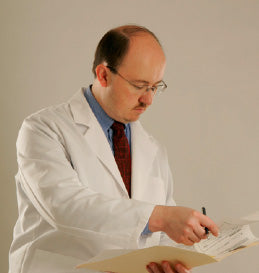By Chris D. Meletis, N.D.
As if hot flashes weren’t bad enough, during menopause you might also experience other symptoms like vaginal dryness and painful intercourse. These symptoms are due to vaginal atrophy, or more specifically what doctors used to call atrophic vaginitis. Now, all of these symptoms are part of the Genitourinary Syndrome of Menopause (GSM). The uncomfortable symptoms of GSM show up as estrogen levels drop and the vaginal wall becomes thin, dry, and irritated. GSM affects 10% to 50% of postmenopausal women.1,2 Yet, only 20 to 25% talk to their doctors about the disorder, often because they’re embarrassed.3
This condition doesn’t just affect your vaginal area—it wreaks havoc on your urinary tract, too. That’s why it’s called the Genitourinary Syndrome of Menopause. If you have this syndrome, you might experience dryness, burning, and irritation in the genital area, lack of lubrication, discomfort or pain, and impaired function during sex.4 It’s also common to have urinary symptoms of urgency, pain, burning, and discomfort during urination, as well as recurrent urinary tract infections.4
It makes sense that the urinary tract is affected by changes to the vagina, as these areas are very close together. A woman’s urethra, where urine is expelled from the body, is connected to the front wall of the vagina and ends between the clitoris and the vagina. Changes that occur in the urethra after menopause make it easier for bacteria to contaminate the urinary tract. This may increase the number of urinary tract infections (UTIs) you get after the change of life. What’s more, a woman’s urethra is only 1.5 inches in diameter, about the width of a tablespoon. Compare this to a man’s urethra, which is 8 inches, making men less vulnerable to UTIs.5
Can Eating Chicken Increase Your Risk of Recurrent Urinary Tract Infections?
One of the most important risk factors for urinary tract infections after menopause is incontinence, or the lack of voluntary control over incontinence. But there’s a lesser known risk factor for recurrent UTIs that scientists have been studying for over a decade. Surprisingly, that factor is eating contaminated chicken. Researchers all over the world have conducted studies that show genetic similarities between antibiotic-resistant E. coli found on chicken and drug-resistant E. coli from humans with UTIs.6-8
In one of those studies, researchers studied chicken, turkey, and pork samples from large retail stores in Flagstaff, Arizona.8 Researchers found E. coli in 79.8% of the samples. The study authors also found a particular strain of E. coli (ST131) in both the poultry samples and blood and urine samples from 72.4% of UTI patients visiting a medical center in Flagstaff.
A Multi-Level Attack On Your Urinary Tract
Another reason why postmenopausal women are often plagued by recurrent UTIs is because more than one type of bacteria is to blame for the infection. Researchers used to think that E. coli was the primary culprit behind all UTIs. And while E. coli is still responsible for most UTIs, in postmenopausal women predisposed to recurrent UTIs, several species of bad bacteria have been found in the bladder tissue.9 One group of researchers showed that urine samples of postmenopausal women with recurrent UTIs included bacteria such as Klebsiella pneumoniae and Enterococcus faecalis, while biopsied tissue included E. coli, Staphylococcus hominis, and Bacillus firmus.9
Even though UTIs can normally be treated with antibiotics, many postmenopausal women suffer from frequent and chronic UTIs. These women are treated with increasingly stronger antibiotics as the bacteria becomes resistant to each medication they try.
Natural UTI Relief
When you have a UTI, it’s important to see your doctor and get antibiotics. Untreated UTIs can lead to a more severe infection and can become fatal. However, if you want to keep your urinary tract healthy in the first place, here are some suggestions.
Probiotics
The population of good and bad bacteria and other microbes in your body are known as the microbiota. Lactobacillus species are the type of bacteria found in the highest levels in a healthy vagina. This type of friendly bacteria is involved in regulating immune responses. Before you go through menopause, estrogen promotes the vaginal colonization with Lactobacillus. In turn, these good bacteria make lactic acid and keep the vaginal pH low. Many bacteria can’t live in a low-pH environment. The Genitourinary Syndrome of Menopause is associated with a decline in estrogen secretion. This results in less lactobacilli and a higher vaginal pH, leading to increased colonization with unhealthy bacteria.10 Scientists have shown that taking an oral probiotic can improve Lactobacillus counts and the vaginal microbiota in women with low estrogen levels.10 Several other clinical studies found that other types of probiotics (L. rhamnosus and L. fermentum) can colonize the vagina, leading to reduced counts of unhealthy bacteria in the urine.11
Vaginal Lubricants and pH Balancing Gels
Although vaginal lubricants are used to relieve symptoms of vaginal dryness and pain during sex, the right kind of vaginal lubricant may have another role to play. Lubricants that contain lactic acid like the can increase levels of lactic acid bacteria. I mentioned the importance of lactic acid bacteria in supporting urinary health earlier in this article. Salvia sclarea (Clary sage) is another great addition to a lubricant. In cell culture studies, it destroyed the cell membranes of E.coli.12 As mentioned above, as women approach menopause their vaginal pH tends to trend upwards. Using a pH balancing gel every 3-4 days can be helpful to restore the pH to a lower level, which allows healthy bacteria to thrive.
Flushing Out The Bad Bacteria
I often remind my postmenopausal patients that it’s even more important during aging to urinate after sex. In addition, if you have bowel incontinence or diarrhea, urinate immediately after your bowel movement to flush out bacteria. The same is true if you sweat a lot during workouts or bike rides. Save a little urine for after regular bowel movements so you can urinate and reduce the risk of bacteria traveling up the urinary tract.
Dr. Chris Meletis
 Dr. Chris Meletis is an educator, international author and lecturer. His personal mission is “Changing World’s Health One Person at a Time.” Dr Meletis has authored 18 books and over 200 national scientific articles in journals including Natural Health, Alternative and Complementary Therapies, Townsend Letter for Doctors and Patients, Life Extension, Natural Pharmacy, and PubMed.gov articles.
Dr. Chris Meletis is an educator, international author and lecturer. His personal mission is “Changing World’s Health One Person at a Time.” Dr Meletis has authored 18 books and over 200 national scientific articles in journals including Natural Health, Alternative and Complementary Therapies, Townsend Letter for Doctors and Patients, Life Extension, Natural Pharmacy, and PubMed.gov articles.
Dr. Meletis served as Dean of Naturopathic Medicine and Chief Medical Officer for 7 years for the National College of Naturopathic Medicine (now the National University of Natural Medicine). He was awarded the 2003 Physician of the Year by the American Association of Naturopathic Physician of the Year by the American Association of Naturopathic Physicians. He has a deep passion for helping the underprivileged and spearheaded the creation of 16 free natural medicine healthcare clinics in the Portland metropolitan area of Oregon.
References:
- Stika CS. Atrophic vaginitis. Dermatol Ther. 2010 Sep-Oct;23(5):514-22.
- Faubion SS, Sood R, Kapoor E. Genitourinary Syndrome of Menopause: Management Strategies for the Clinician. Mayo Clin Proc. 2017 Dec;92(12):1842-9.
- Kraft S. What’s to know about atrophic vaginitis. Medical News Today. 2018 Jan. https://www.medicalnewstoday.com/articles/189406.php Accessed July 20, 2019.
- Portman DJ, Gass ML. Genitourinary syndrome of menopause: new terminology for vulvovaginal atrophy from the International Society for the Study of Women's Sexual Health and the North American Menopause Society. Maturitas. 2014 Nov;79(3):349-54.
- Basic Human Anatomy. Chapter 33: The ureter, bladder and urethra. Available at https://humananatomy.host.dartmouth.edu/BHA/public_html/part_6/chapter_33.html Accessed July 21, 2019.
- Bergeron CR, Prussing C, Boerlin P, et al. Chicken as reservoir for extraintestinal pathogenic Escherichia coli in humans, Canada. Emerg Infect Dis. 2012 Mar;18(3):415-21.
- Manges AR, Johnson JR. Food-Borne Origins of Escherichia coli Causing Extraintestinal Infections. Clinical Infectious Diseases. 2012 Sep;55(5):712-9.
- Liu CM, Stegger M, Aziz M, et al. Escherichia coli ST131-H22 as a Foodborne Uropathogen. MBio. 2018 Aug 28;9(4).pii: e00470-18.
- De Nisco NJ, Neugent M, Mull J, et al. Direct Detection of Tissue-Resident Bacteria and Chronic Inflammation in the Bladder Wall of Postmenopausal Women with Recurrent Urinary Tract Infection. J Mol Biol. 2019 Apr 17. [Epub ahead of print].
- Marschalek J, Farr A, Marschalek ML, et al. Influence of Orally Administered Probiotic Lactobacillus Strains on Vaginal Microbiota in Women with Breast Cancer during Chemotherapy: A Randomized Placebo-Controlled Double-Blinded Pilot Study. Breast Care (Basel). 2017 Oct;12(5):335-9.
- Raz R. Urinary tract infection in postmenopausal women. Korean J Urol. 2011 Dec;52(12):801-8.
- Cui H, Zhang X, Zhou H, et al. Antimicrobial activity and mechanisms of Salvia sclarea essential oil. Bot Stud. 2015 Dec;56(1):16.







